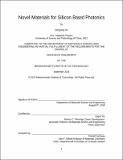Novel materials for silicon based photonics
Author(s)
Du, Qingyang
DownloadFull printable version (3.477Mb)
Other Contributors
Massachusetts Institute of Technology. Department of Materials Science and Engineering.
Advisor
Juejun Hu.
Terms of use
Metadata
Show full item recordAbstract
A complete photonic chip must include the following components: a light source, usually lasers, an isolator, a waveguide, a modulator and a photodetector. Limited by material intrinsic properties, silicon alone cannot realize all the above mentioned functions. The development of silicon photonics has found its way through exploiting novel materials as hybrid platforms to manufacture various devices and systems. In this thesis, we focus on the development of novel material in emerging needs of broadband coherent light source and optical isolators. Chalcogenide glass stands out among the candidates for light generation and sensing due to its large non-linear figure of merit and wide transparency window in the IR spectral range, while magnetic garnet still presents the best device performance among magneto-optical isolators owing to the ease of phase formation and relatively low material absorption. We first investigated the fabrication technology of chalcogenide glass and developed a process flow to produce low loss planar chalcogenide glass waveguides. Using electron beam lithography to minimize sidewall roughness and reactive ion etch to achieve vertical sidewalls. We managed to demonstrate a record low loss of 0.5 dB/cm in single mode core chalcogenide waveguides. Based on this low loss platform, we integrated a supercontinuum light source onto a sensor chip. Our work presented a step forward towards miniaturization photonic sensor chips. Next, we focused on a hybrid platform of chalcogenide glass and magnetic garnet. By carefully designing device architecture, a monolithically integrated TM polarized magneto-optical (MO) isolator with 3 dB insertion loss and 40 dB isolation ratio was demonstrated. Both parameter sets record among current monolithically integrated on-chip MO isolators. Meanwhile, we also demonstrated a monolithically integrated MO isolator with TE polarization featuring 11.5 dB insertion loss and 20 dB isolation ratio. Lastly, we leveraged cavity enhanced spectroscopy platform to study radiation induced effect on SiNx, a-Si and SiC materials. We found a refractive index modulation to the order of 10⁻³ after receiving 10 Mrad Gamma radiation dose.
Description
Thesis: Ph. D., Massachusetts Institute of Technology, Department of Materials Science and Engineering, 2018. This electronic version was submitted by the student author. The certified thesis is available in the Institute Archives and Special Collections. Cataloged from student-submitted PDF version of thesis. Includes bibliographical references.
Date issued
2018Department
Massachusetts Institute of Technology. Department of Materials Science and EngineeringPublisher
Massachusetts Institute of Technology
Keywords
Materials Science and Engineering.